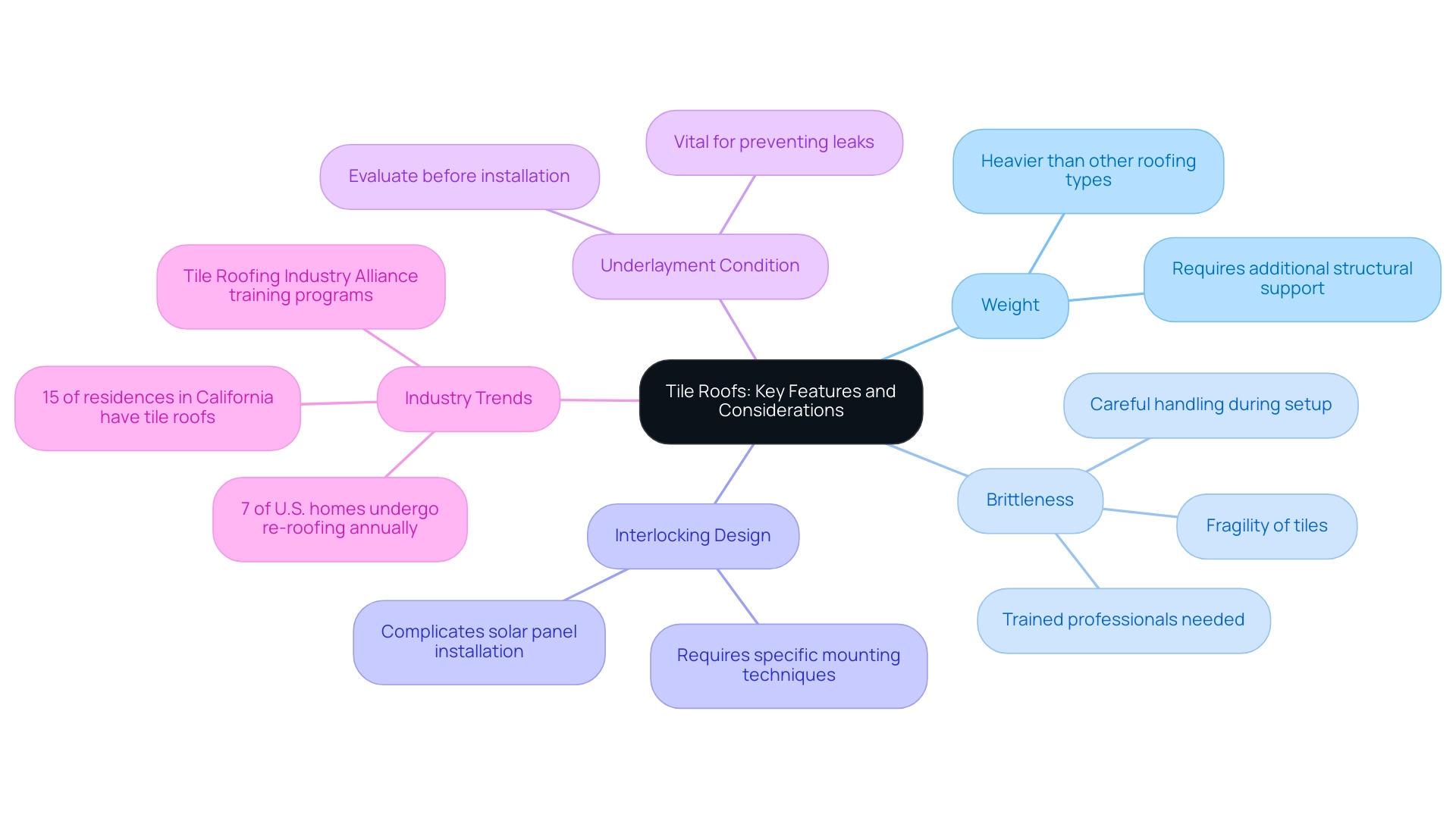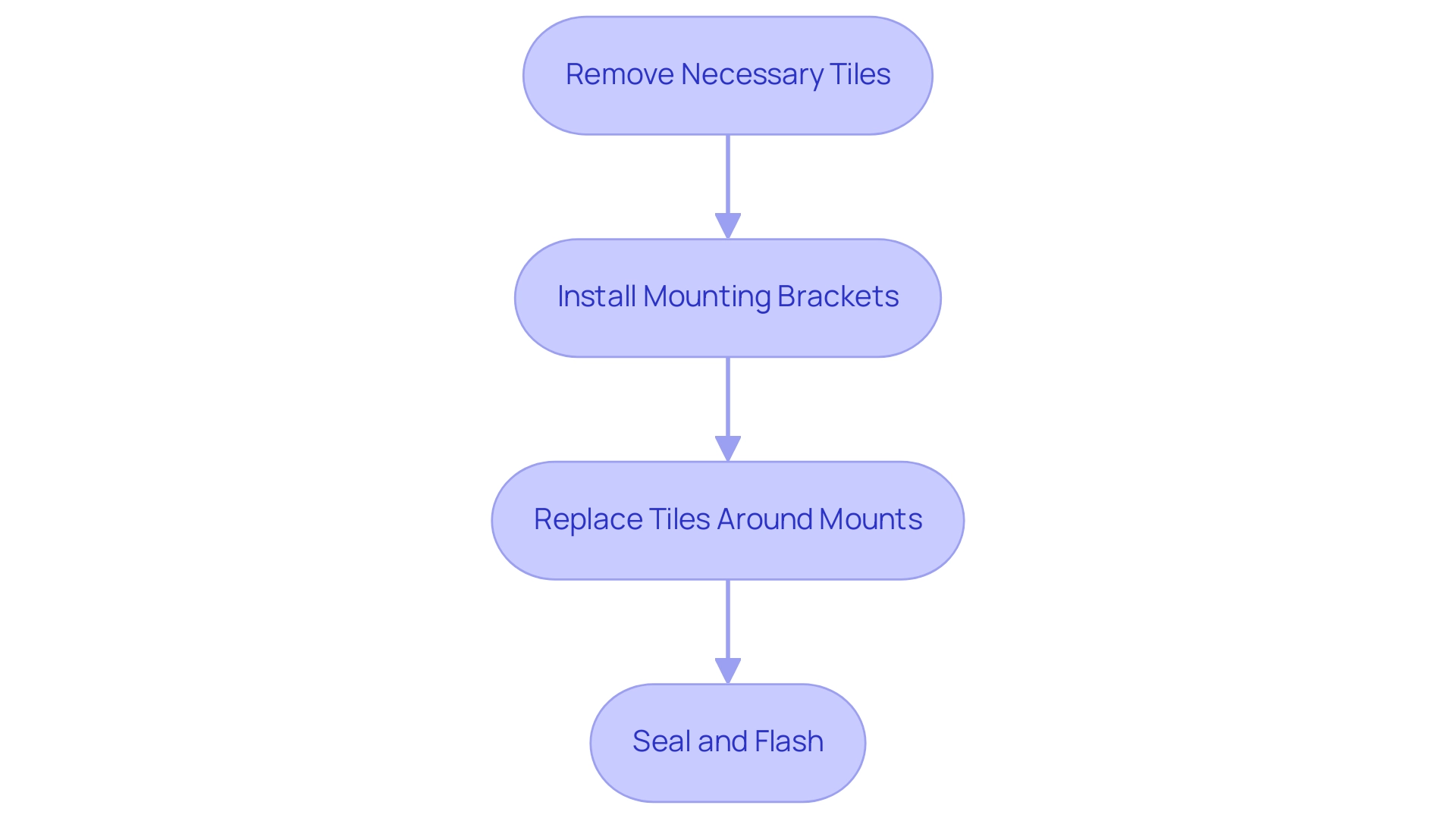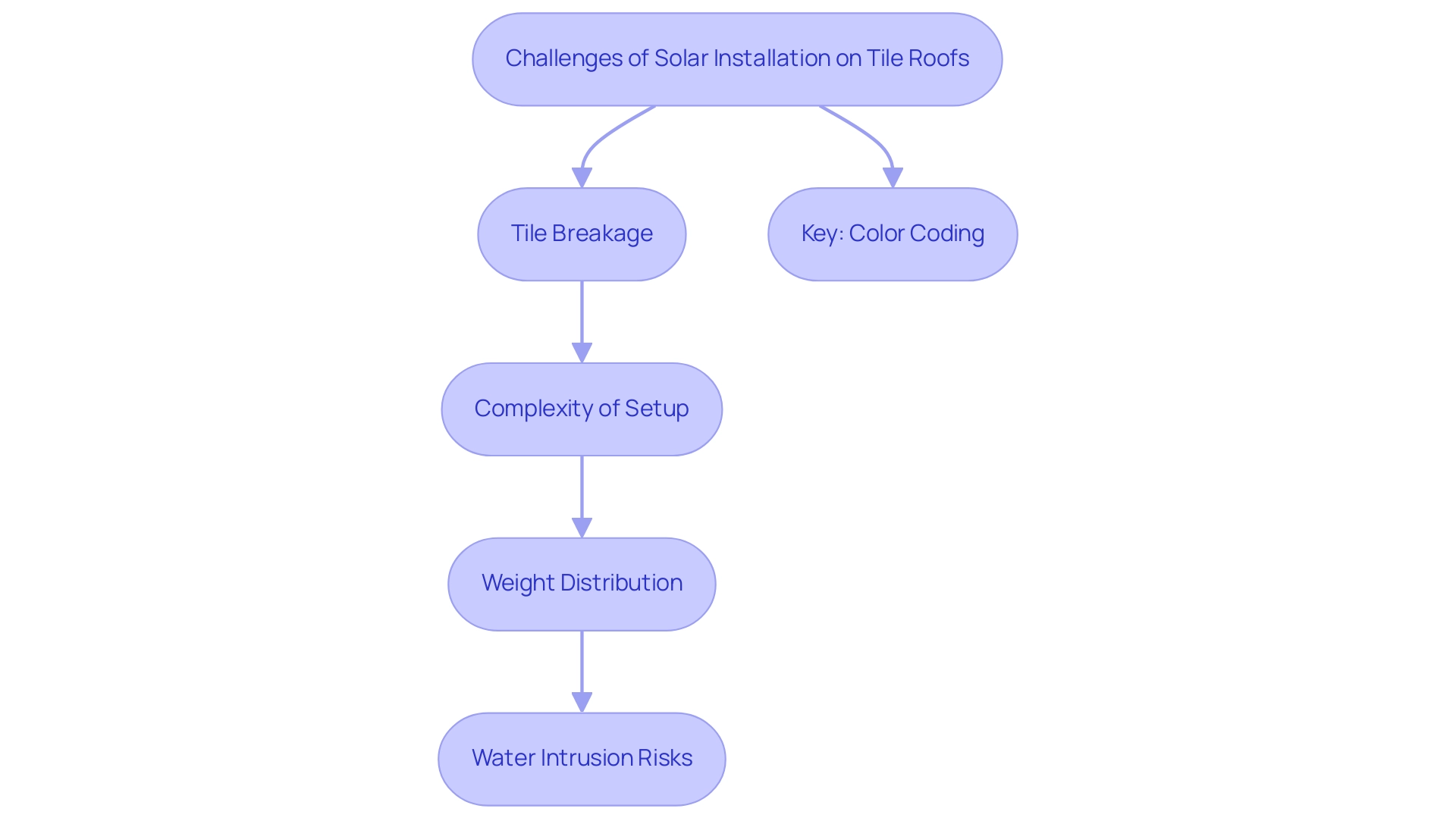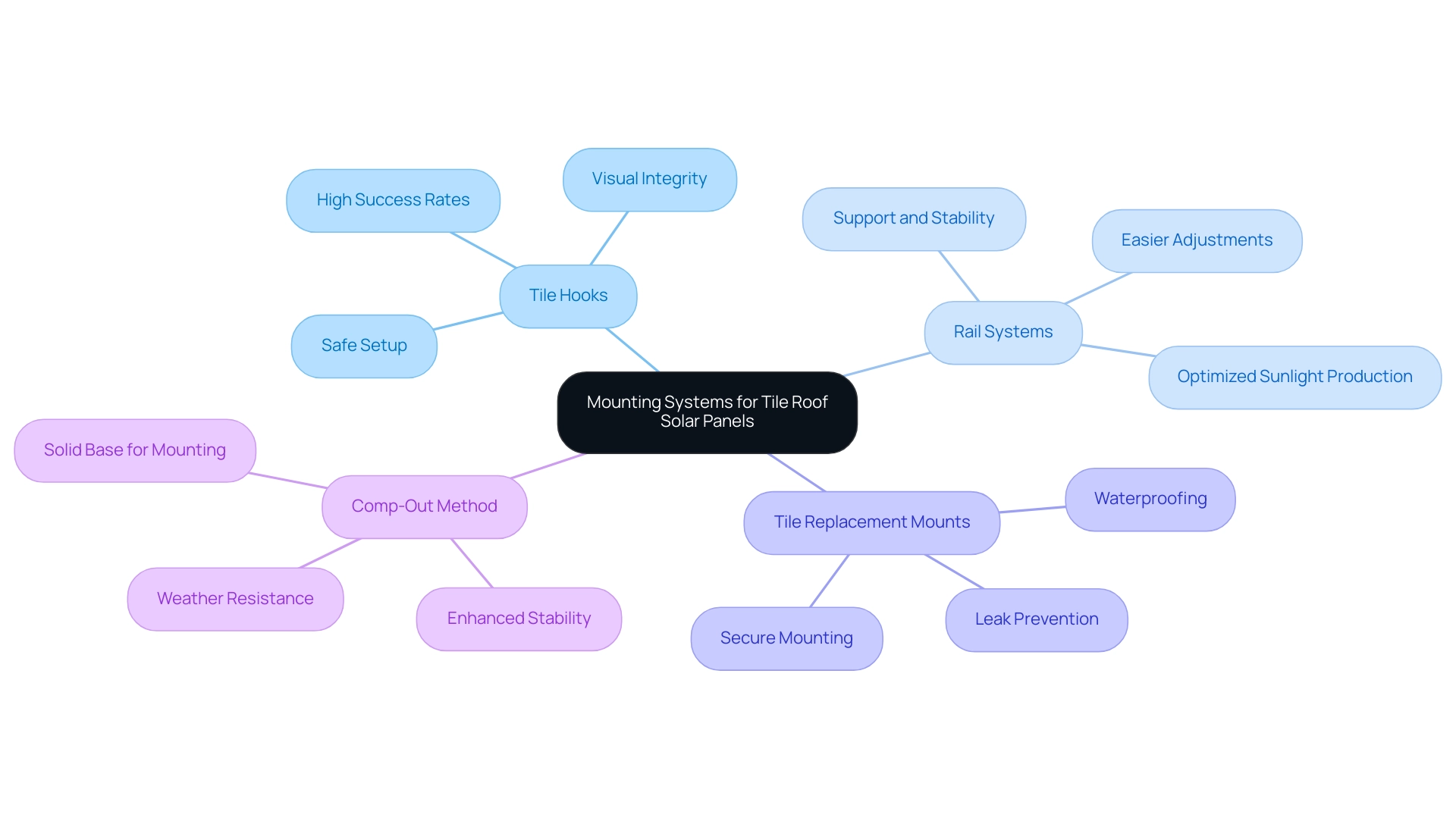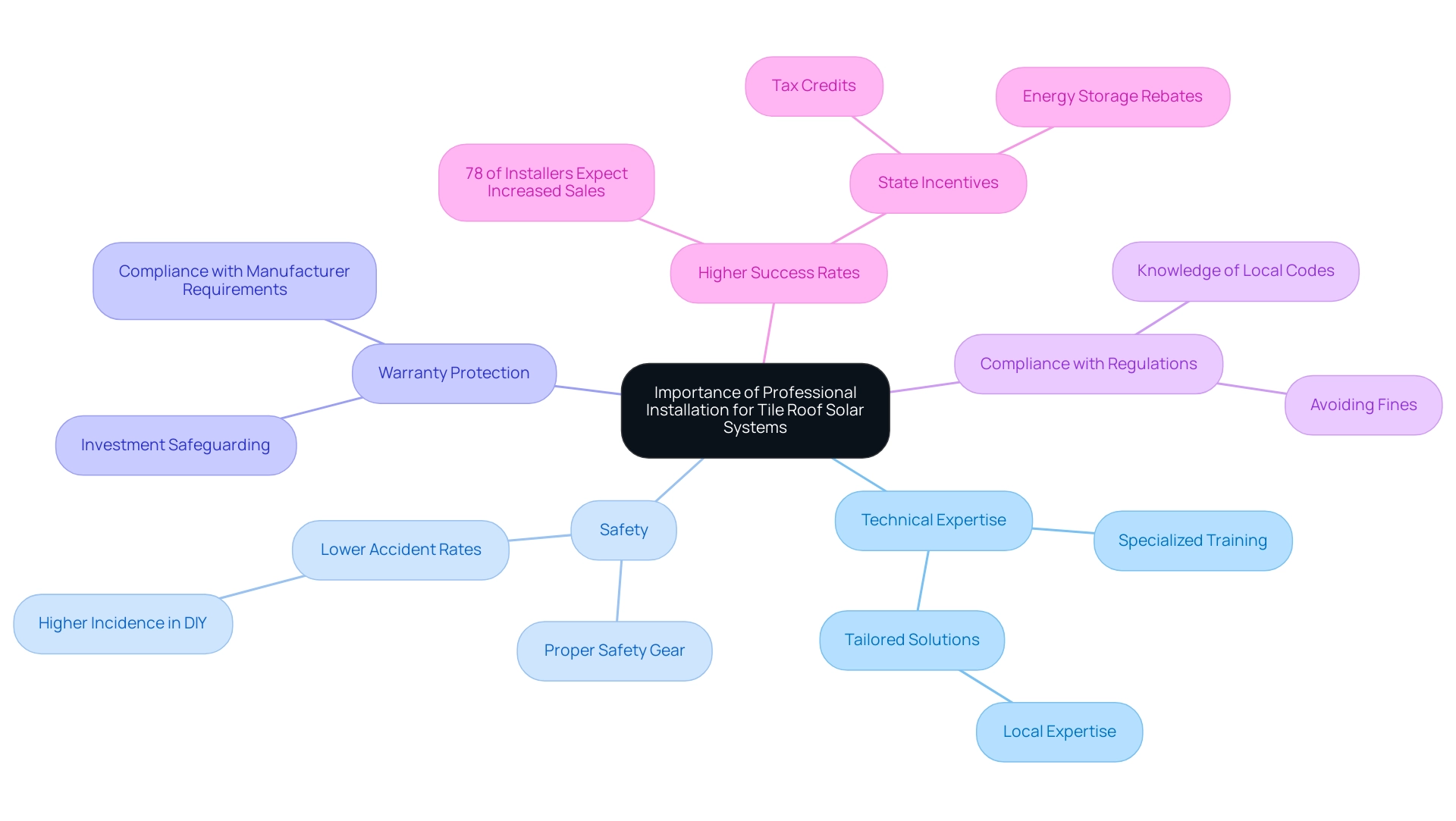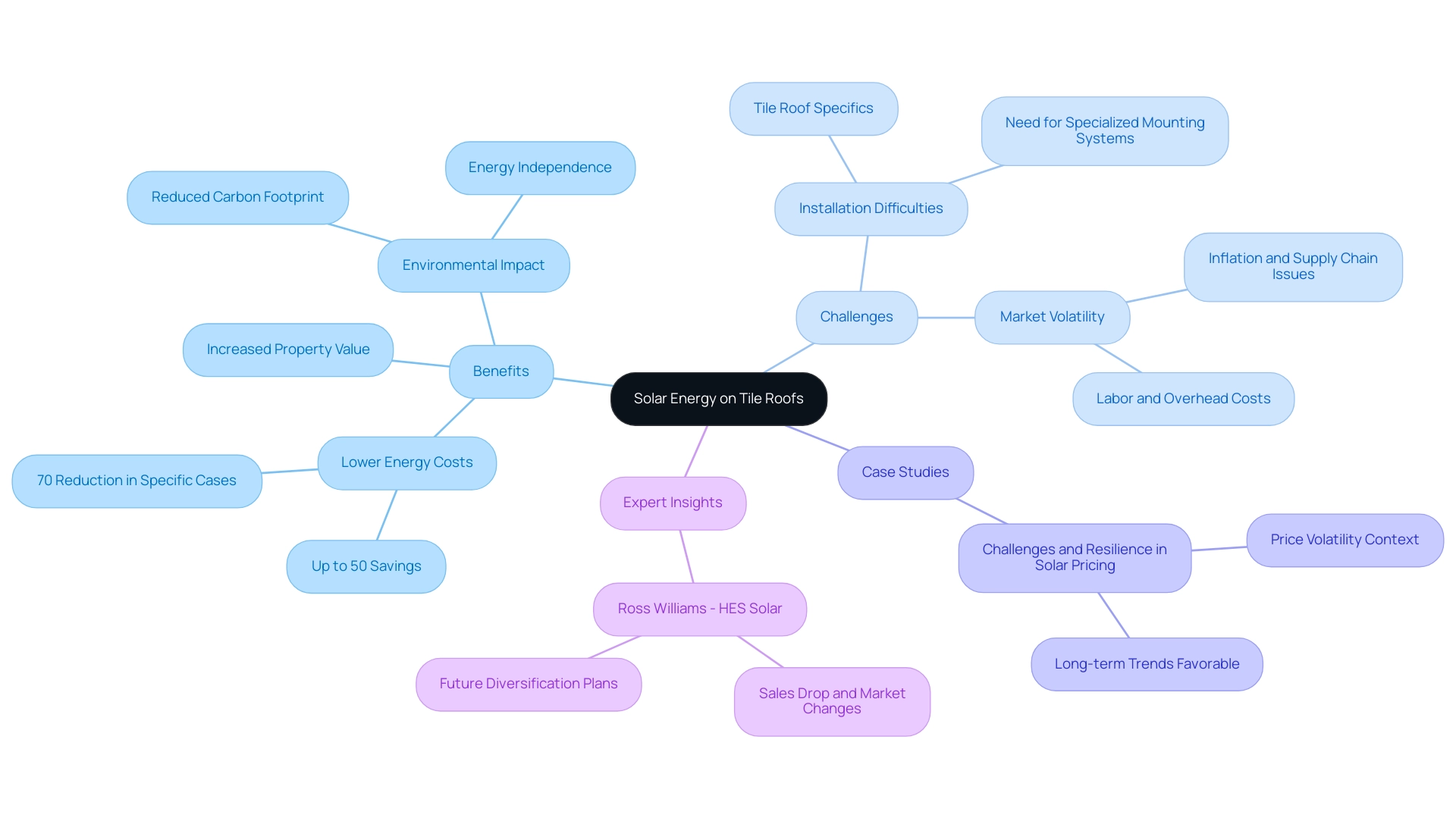Overview
This article serves as a compassionate guide for homeowners contemplating the installation of solar panels on tile roofs. We understand that energy bills can be a significant concern, and exploring sustainable solutions is a step towards alleviating that burden. Solar energy not only offers a path to energy independence but also contributes to a healthier planet. However, installing solar panels on tile roofs comes with unique challenges that require careful consideration.
Professional installation is crucial in navigating these challenges, such as ensuring proper weight distribution and addressing tile brittleness. By prioritizing these factors, you can maintain the integrity of your roof while optimizing the efficiency of your solar system. We want you to feel confident in your decision, knowing that expert guidance is available to support you every step of the way.
Together, we can embark on this journey towards sustainability, making informed choices that benefit both your home and the environment. If you’re ready to take the next step, please reach out to us for personalized assistance. Your path to energy independence starts here, and we’re here to help you achieve it.
Introduction
In the journey towards sustainable energy solutions, many homeowners are understandably concerned about rising energy bills. It’s common to feel overwhelmed by the options available, but we want you to know that solar power offers a promising path forward. Tile roofs, known for their durability and beauty, can effectively support solar installations, making them a unique opportunity for those looking to embrace renewable energy. However, we also recognize that this transition comes with its own set of challenges, requiring specialized knowledge and techniques to ensure a successful outcome.
This article aims to guide you through the key considerations for installing solar panels on tile roofs. We will explore essential features to be aware of, best practices for installation, and potential challenges that may arise. By understanding these factors, you can make informed decisions that not only enhance your energy efficiency but also contribute to a greener future.
As the trend towards renewable energy continues to grow, integrating solar technology into tile roofs is becoming an increasingly viable option. Together, we can work towards reducing your carbon footprint while enjoying the numerous benefits of clean energy. Let’s embark on this journey towards energy independence, ensuring that your home not only meets your needs but also supports a sustainable future for our planet.
Understanding Tile Roofs: Key Features and Considerations
Tile coverings are beloved for their durability and aesthetic charm, typically crafted from materials like clay or concrete. We understand that when considering solar panel installation on tile roofs, several key features deserve your attention:
- Weight: Tile roofs tend to be heavier than other roofing types, which may require additional structural support to accommodate the weight of solar panels. This consideration is essential for maintaining the integrity of both your home and the energy system.
- Brittleness: The fragility of tiles necessitates careful handling during setup to avoid cracking. It’s crucial that professionals are trained in proper techniques to mitigate the risk of damage, especially during the mounting process.
- Interlocking Design: Many tile roofs feature an interlocking design that can complicate solar panel installation. This unique structure requires specific mounting techniques to ensure a secure and effective setup.
- Underlayment Condition: The condition of the underlayment beneath the tiles is vital; any signs of deterioration can lead to leaks and other issues. Evaluating and resolving the underlayment’s condition before installation is essential to avoid future complications.
In California, approximately 15% of residences have tile coverings, making them a significant factor for photovoltaic setups. The durability of tile coverings is impressive, with a lifespan ranging from 25 to 50 years, aligning well with the longevity of photovoltaic panels. As the trend towards renewable energy continues to expand, specialists forecast a rise in solar installations on tile roofs, driven by innovations in mounting technology and an increased focus on sustainable energy solutions.
Recent industry training initiatives, like those from the Tile Roofing Industry Alliance, enhance the skills of roofing experts, ensuring they are well-prepared to tackle the unique challenges of installing solar on tile roofs. These initiatives not only improve installation quality but also elevate overall industry standards, fostering a more knowledgeable workforce.
As homeowners increasingly strive to harness renewable energy, understanding the specific factors and advantages of tile structures will be crucial for successful installations. With around 7% of the 75 million single-family houses in the U.S. undergoing re-roofing annually, there is a significant opportunity to incorporate renewable energy solutions into new tile roof setups. One satisfied customer, Brian D., shared, “Another fine job by Josh and his crew. They started early and worked late to finish the job in one day,” underscoring the importance of skilled professionals in ensuring quality installations. This dedication to excellence aligns with Powercore Electric’s mission to provide eco-conscious homeowners with reliable energy solutions that enhance efficiency and contribute to long-term sustainability.
Techniques for Installing Solar Panels on Tile Roofs
Installing solar on a tile roof requires thoughtful planning and execution to ensure both functionality and aesthetics. We understand that homeowners may feel overwhelmed by the process, so here’s a comprehensive step-by-step guide to help you navigate this journey:
-
Remove Necessary Tiles: Begin by carefully removing the tiles from the designated installation area. This may involve taking out several tiles to create a clear space for the mounting system.
-
Install Mounting Brackets: Utilize specialized mounting brackets designed specifically for tile surfaces. These brackets should be firmly attached to the rafters, offering a stable base for the photovoltaic panels.
-
Replace Tiles Around Mounts: Once the brackets are in place, replace the tiles around the mounts. This step is crucial for maintaining the structure’s integrity and ensuring a seamless appearance.
-
Seal and Flash: To prevent water intrusion, apply flashing and sealant around the mounts. This creates a watertight setup, protecting your structure from potential leaks.
Techniques for Mounting Photovoltaic Panels on Tile Surfaces
When it comes to mounting photovoltaic panels on tile surfaces, several techniques can enhance the process:
- Use of Ballast Systems: For flat concrete or rubber surfaces, ballast systems can be employed to secure photovoltaic panels without penetrating the surface, minimizing the risk of leaks.
- Slanted Metal Racking: This method is effective for both flat and sloped surfaces, allowing for optimal panel positioning and drainage.
Best Practices for Setup
To ensure a successful process, consider the following best practices:
- Consult with Experts: Engaging with photovoltaic mounting professionals can provide valuable insights into the best techniques and materials for your specific surface type. This is especially significant for environmentally aware homeowners who wish to optimize efficiency and sustainability.
- Adhere to Local Regulations: Ensure compliance with local building codes and regulations, which may dictate specific setup practices.
Average Setup Time
The average duration required to set up solar on tile roofs can vary based on the complexity of the roof and the size of the system. Generally, setups can require anywhere from one to three days, based on these factors.
Financial Considerations
The expense of photovoltaic panels has dropped considerably in recent years, making renewable power a more attainable investment for homeowners. However, the initial investment can still be substantial, especially for larger systems. Understanding these financial factors is essential for eco-conscious homeowners contemplating the installation of renewable energy systems. Furthermore, the economic advantages of photovoltaic power extend beyond personal savings, aiding in job creation and decreasing greenhouse gas emissions, aligning with broader sustainability objectives.
Case Study: University of Cuenca
A relevant case study is the 7 kWp photovoltaic system installed at the University of Cuenca in Ecuador. This system was designed to partially supply power to the Faculty of Architecture and Urbanism without storage or grid connection. While it accounted for roughly 7.5% of the total annual power demand, fluctuations in usage on non-working days restricted its effectiveness, leading to merely 0.17% surplus output each year. This emphasizes the significance of comprehending power usage trends when organizing photovoltaic installations. Insights from this case study can inform homeowners about how their usage can impact the efficiency of their renewable systems.
The Renewable Workforce
According to the International Energy Agency (IEA), 3.9 million people work in solar technology across the world. This statistic highlights the increasing significance of sun-based energy as a feasible and sustainable power source, further stressing the advantages of investing in photovoltaic technology for both individual homeowners and the broader community. By adhering to these techniques and best practices, together we can effectively install panels on tiled surfaces, contributing to energy independence and sustainability.
Challenges of Solar Installation on Tile Roofs: What to Expect
Setting up photovoltaic panels on tiled surfaces can be daunting, and we understand the concerns that come with it. There are notable obstacles that can influence both the setup procedure and the enduring effectiveness of your energy system:
- Tile Breakage: One of the most pressing concerns is the risk of breaking tiles during the process. Research indicates that around 10-15% of tiled surfaces encounter damage during solar panel setup, leading to unforeseen repair expenses and potential delays in project completion.
- Complexity of Setup: The interlocking structure of tiled surfaces adds a layer of difficulty to the installation process. This unique structure requires skilled labor and specialized tools to ensure that panels are installed correctly without damaging the existing roofing material.
- Weight Distribution: Solar panels add considerable weight to a surface, necessitating a thorough assessment of its structural integrity. In some cases, structural reinforcements may be required to support the additional load, complicating and lengthening the timeline for setup.
- Water Intrusion Risks: Proper sealing is critical to prevent water intrusion, which can lead to leaks and damage over time. Following best practices for flashing and sealing is essential to reduce these risks and guarantee the durability of both the roof and the solar system.
To enhance the performance of your solar setup, it’s vital to know that solar panels should ideally face south to obtain 5 to 6 hours of direct sunlight daily. This orientation is crucial for maximizing power generation.
Real-world instances, such as the installation of a 7 kWp photovoltaic system at the University of Cuenca, highlight these challenges. This system, designed to partially power the Faculty of Architecture and Urbanism, faced significant consumption fluctuations that underscored the limitations of power generation without a grid connection. The difficulties of weight distribution and water intrusion risks were particularly evident, emphasizing the necessity for meticulous planning and execution.
Moreover, companies like Lyndsey Roofing, LLC in Poughkeepsie, NY, are addressing these issues by providing expert shingle installation tailored for different types of coverings, including solar on tile roof installations. Their approach demonstrates how modern solutions can assist homeowners in navigating the intricacies of photovoltaic setup on tiled surfaces, ensuring that you can enjoy the benefits of renewable sources without compromising the integrity of your roof. Additionally, exploring options like Tesla home chargers and understanding government programs can enhance your overall renewable energy experience, making the transition to sustainable energy more accessible and efficient. Together, we can work towards a brighter, greener future.
Top Tips for a Successful Solar Installation on Tile Roofs
To achieve a successful solar installation on tile roofs, it’s essential to consider a few important tips that can ease your transition to renewable energy:
-
Hire Experienced Installers: We understand that selecting the right contractors can feel overwhelming. Choosing specialists in tile roof installations is crucial. Their expertise ensures that proper techniques are employed, minimizing the risk of damage and maximizing efficiency. With approximately 4,100 openings for photovoltaic installers projected annually, the demand for skilled professionals is on the rise. This highlights the importance of hiring experienced specialists. Significantly, 34% of renewable energy workers are in setup or maintenance positions, underscoring the value of employing experts in the renewable energy setup process. Powercore Electric, with over 30 years of experience serving California, is committed to delivering exceptional service and quality craftsmanship.
-
Examine the Top Structure: It’s common to feel concerned about the integrity of your roof. Before setup, perform a comprehensive assessment of the top structure to detect any current damage or required repairs to the underlayment. This proactive method can greatly improve the success rate of the setup, as a well-kept structure offers a strong base for photovoltaic panels.
-
Use Quality Materials: You deserve a solar setup that lasts. Investing in high-quality mounting systems and sealants is vital for ensuring the durability and performance of your solar installation. Quality materials can withstand the unique challenges posed by solar on tile roofs, contributing to the longevity of the system.
-
Plan for Maintenance: We know that maintenance is often a concern. Design the installation with maintenance in mind. Ensure that the layout allows for easy access to the panels for cleaning and routine maintenance, which is essential for optimal performance over time. Routine expert cleaning can improve efficiency, prolong the lifespan of your panels, and aid in creating a cleaner environment by sustaining optimal production. This proactive maintenance strategy not only safeguards your investment but also decreases dependence on grid power, thereby minimizing your carbon footprint.
These approaches not only enable a more seamless setup process but also enhance the overall efficiency of your renewable power system, ensuring you can enjoy the advantages of clean power for years ahead. As one satisfied customer noted, “Ryan and his team were great. They were quick, effective, and adhered to the timeline for our energy system setup,” reflecting the positive experiences many have had with Powercore Electric.
Their internal group of specialists ensures high-quality setups and maintenance, making them a reliable option for homeowners seeking to switch to sustainable energy practices. Together, we can work towards a brighter, cleaner future.
Exploring Mounting Systems for Tile Roof Solar Panels
When it comes to evaluating photovoltaic panel setups on tiled structures, we understand that homeowners are seeking effective and reliable solutions. Several mounting systems stand out for their ability to meet these needs:
- Tile Hooks: Specifically designed to fit the unique contours of tiled structures, tile hooks attach directly to the rafters. This approach not only guarantees a safe setup but also preserves the visual integrity of your home. Their compatibility with the roof’s structure has shown high success rates, making them a preferred choice for many homeowners.
- Rail Systems: Often used in conjunction with tile hooks, rail systems provide additional support and stability for photovoltaic panels. They allow for easier adjustments and alignments, enhancing the overall efficiency of the installation. This flexibility can be especially advantageous in optimizing sunlight production.
- Tile Replacement Mounts: This innovative method involves substituting specific tiles with waterproof mounts. This not only secures the photovoltaic panels effectively but also prevents potential leaks, ensuring the longevity of both your structure and the energy system.
- Comp-Out Method: By removing tiles and replacing them with a solid base for mounting, the comp-out method significantly enhances stability. This method is particularly beneficial in regions susceptible to strong winds or extreme weather situations.
Recent research suggests that roof tiles designed for sustainable use can reduce around 335.7 kg CO2 equivalent greenhouse gas emissions through their renewable power generation. This statistic resonates with our commitment at Powercore Electric to sustainability and energy independence, as we focus on helping homeowners like you transition to cleaner energy solutions. Investing in renewable energy technology not only reduces utility costs but also protects you from the volatility of power prices and decreases reliance on fossil fuels.
Moreover, it aids in job generation and supports fair access initiatives, such as the Biden-Harris administration’s $7 billion Solar for All program, fostering a more sustainable future for everyone.
In addition, developments in tracking technology have streamlined the setup process, decreasing the number of necessary piles and cutting maintenance expenses compared to earlier years. This advancement not only simplifies the setup but also improves the overall efficiency of energy systems. In terms of performance, research has indicated that modules fixed directly to the deck tend to operate at higher temperatures and generate less power than those employing a counter-batten system.
However, both systems exceed conventional rack-mounted modules regarding efficiency, emphasizing the significance of choosing the appropriate mounting system.
The selection of a mounting system can greatly affect the success of solar on tile roof energy setups. Tile hooks, for example, have shown high success rates because of their compatibility with your building’s structure, while rail systems provide flexibility and simplicity in setup. By choosing the suitable mounting option for solar on tile roofs, you can optimize your energy generation while ensuring the integrity of your tile structures.
At Powercore Electric, our vast experience in renewable energy setups ensures that you receive top-notch service and assistance, aligning with our mission to deliver effective energy solutions for homeowners. Together, we can work towards a brighter, more sustainable future.
Cost Analysis: Is Solar Installation on Tile Roofs Worth It?
When considering solar installation on tile roofs, it’s natural to weigh the costs and benefits involved.
-
Installation Costs: The complexity of tile roofs often leads to higher installation costs, typically ranging from $15,000 to $30,000. Factors that influence this range include the size of the solar system and specific installation requirements unique to tile roofing. As Robert Tschudi, a licensed general contractor, shares, “We recently installed a solar panel system on a coastal property prior to a hurricane. This involved installing special anti-wind mounts to secure the panels in high winds. The additional expense was highly justified, as the panels withstood the storm flawlessly and continued to provide power.”
-
Savings on Utilities: Homeowners can experience substantial reductions on their bills, with many reporting decreases of 50% or more. In fact, transitioning to renewable sources can lead to yearly savings ranging from $650 to $1,500, making it a financially wise investment over time.
-
Increased Property Value: Installing photovoltaic panels can significantly enhance property value. Homes fitted with energy systems are often more attractive to prospective buyers, as they signify a commitment to sustainability and reduced energy expenses.
-
Tax Incentives: Federal and state incentives play a crucial role in making renewable energy setups more affordable. With the average expense of a panel system around $27,173, these incentives can effectively reduce the net cost to approximately $20,000, offering a compelling financial advantage.
-
Cost Evaluation: A comprehensive cost evaluation for solar on tile roofs in 2025 suggests that although initial expenditures might be elevated, the long-term financial advantages, including savings on utilities and enhanced property value, surpass these expenses. Homeowners can expect a return on investment that enhances their financial stability while contributing to a sustainable future.
-
Expert Insights: Financial advisors emphasize the importance of assessing savings from power sources when reviewing panel setups. The long-term decrease in electricity costs can make renewable power a feasible choice for homeowners seeking to improve their power autonomy.
With over 30 years of experience serving the California community, Powercore Electric’s in-house team of specialists guarantees high-quality setups, aligning with their dedication to outstanding service. Satisfied customers consistently recognize Powercore Electric for its efficiency and commitment to community service. By understanding these factors, together we can make informed choices about switching to renewable energy, ensuring we maximize both our financial and environmental benefits.
The Importance of Professional Installation for Tile Roof Solar Systems
Professional installation is essential for solar systems on tile roofs, and we understand that homeowners may have concerns about energy bills. Here are several key reasons why choosing professionals is the best decision for your home:
-
Technical Expertise: Professionals possess the specialized training and experience necessary to address the unique challenges posed by tile roofs. Their expertise guarantees that setup methods are performed accurately, enhancing the effectiveness and lifespan of the energy system. At Powercore Electric, our local expertise allows us to tailor solutions that meet the distinct electrical and solar needs of California communities.
-
Safety: It’s common to feel apprehensive about the risks associated with working at heights. Professional installers are equipped with the appropriate safety gear and adhere to strict safety protocols, significantly reducing the likelihood of accidents during setup. Safety experts highlight that occurrences during DIY tasks can result in severe injuries, with average safety incidents during DIY projects being significantly higher than those involving trained professionals.
-
Warranty Protection: We know how important it is to protect your investment. Numerous solar panel and roofing material producers specify that professional setup is a prerequisite for warranty coverage. This protection is crucial for homeowners, as it safeguards their investment against potential defects or issues that may arise post-installation. At Powercore Electric, we guarantee that every setup meets the highest standards of quality, safety, and efficiency, providing peace of mind for our customers.
-
Compliance with Regulations: Navigating local building codes and regulations can feel overwhelming. Experts are well-versed in these requirements, ensuring that setups comply with all legal standards, which can prevent costly fines or the need for redoing. Our commitment to customer-first service means we prioritize your satisfaction and work hard to exceed your expectations at every turn.
The significance of professional setup is further emphasized by statistics indicating that systems installed by experts have a higher success rate. In fact, 78% of installers anticipate they will sell more photovoltaic systems in 2025, highlighting the growing acknowledgment of the benefits that professional setup provides to homeowners seeking to invest in renewable resources. Furthermore, state incentives, like tax credits and energy storage rebates, strengthen demand for renewable energy and motivate homeowners to contemplate expert setup.
Moreover, the case analysis named ‘Uncertainty in the Solar Sector for 2025′ demonstrates the possible effects of political and economic elements on the renewable energy industry, which could influence homeowners’ choices concerning setup. As Ben Zientara, a renewable energy policy analyst, points out, the future of energy setups will rely on whether current political actions support or obstruct the process, emphasizing the importance for homeowners to remain informed.
In conclusion, the blend of technical knowledge, safety protocols, warranty coverage, and regulatory adherence renders professional setup for solar on tile roofs not merely a suggestion, but an essential element of a successful renewable investment. At Powercore Electric, we are driven by sustainability, offering energy-efficient solutions that not only reduce your carbon footprint but also maximize savings for your home. Our pleased clients have shared their favorable experiences, emphasizing how our expert installation has transformed their resource usage and contributed to a greener future. Together, let’s work towards a sustainable future that benefits both you and the environment.
Embracing Solar Energy for Your Tile Roof
Installing solar on tile roofs presents a practical and beneficial solution for homeowners who are eager to embrace renewable resources. We understand that managing energy costs can be a significant concern, and this method not only helps in lowering those costs but also increases property value and contributes to a smaller carbon footprint. As California continues to lead the nation in renewable power adoption, with projections indicating an additional 22,982 MW of photovoltaic capacity to be installed over the next five years, more homeowners are recognizing the advantages of integrating this technology into their residences.
This growth truly underscores California’s commitment to renewable energy and the opportunities it presents for eco-conscious homeowners.
While tiled coverings are visually appealing, they can pose specific challenges for panel installation. However, with the right techniques and professional expertise from Powercore Electric, these challenges can be effectively managed. Employing specialized mounting systems designed for tile roofs ensures that the integrity of the roof is preserved while enhancing panel performance. This is essential, as homeowners can enjoy the dual advantages of efficiency and aesthetic appeal.
The environmental impact of adopting solar energy is significant. By switching to renewable energy, homeowners can drastically reduce their reliance on fossil fuels, thereby lowering their carbon emissions. It’s common to feel overwhelmed by the scale of climate change, but environmentalists emphasize that each energy installation contributes to a collective effort in combating this issue, making it a responsible choice for eco-conscious homeowners.
As one environmentalist observed, “The transition to renewable sources is not merely an individual decision; it’s a crucial move towards a sustainable future for our planet.”
Successful case studies demonstrate the efficiency of solar on tile roofs. For instance, numerous homeowners have reported substantial savings on their utility bills, with some experiencing reductions of up to 50%. A notable case from Southern California highlighted a household that experienced over a 70% reduction in energy costs after installing a water heating system through Powercore Electric. These financial advantages, coupled with the potential for enhanced property value, make renewable energy systems an appealing investment. Additionally, the case study titled “Challenges and Resilience in Pricing” highlights how, despite recent volatility in prices, the long-term trend remains favorable for homeowners looking to invest in renewable technology.
Expert insights further emphasize the benefits of solar on tile roofs for homeowners. By utilizing renewable energy, homeowners not only achieve energy independence but also protect themselves from rising utility expenses. As Ross Williams, owner of HES Solar, noted, “The market has experienced significant changes, but those who invest in renewable energy now will reap the benefits in the long run.”
As the market for solar technology continues to evolve, the long-term benefits of installing solar on tile roofs become increasingly clear, paving the way for a more sustainable future. Together, we can work towards a greener tomorrow. Powercore Electric is committed to providing tailored solutions that meet the unique needs of California homeowners, ensuring a customer-first approach that prioritizes satisfaction and quality service.
Conclusion
We understand that many homeowners are concerned about rising energy bills and are seeking sustainable solutions. Embracing solar energy through the installation of solar panels on tile roofs is not just a practical choice; it’s a compelling opportunity to enhance your sustainability efforts. Tile roofs, celebrated for their durability and aesthetic appeal, can effectively support solar installations when approached with the right techniques and professional expertise. By recognizing the unique challenges posed by tile roofs—such as weight distribution, tile fragility, and the complexity of installation—you can make informed decisions that lead to successful solar solutions.
The benefits of integrating solar technology into your home are substantial. Imagine experiencing significant energy savings, with many homeowners reporting reductions of up to 50% on their energy bills. Additionally, solar installations can enhance your property value and contribute to a decrease in carbon emissions, aligning your personal investments with broader environmental goals. As California continues to advance its solar capacity, the opportunity for eco-conscious homeowners to contribute to a greener future is more accessible than ever.
It’s common to feel overwhelmed by the complexities of working with tile roofs, which is why engaging experienced professionals for installation is critical. Their expertise ensures compliance with regulations and safety standards while maximizing the efficiency and longevity of your solar system. By investing in quality materials and adopting best practices, you can enjoy the dual benefits of energy efficiency and aesthetic integrity, making solar energy a truly worthwhile investment.
In conclusion, transitioning to solar energy on tile roofs is not just a trend; it’s a vital step towards energy independence and sustainability. Together, we can confidently embark on this journey, contributing to a cleaner environment while reaping the financial rewards of renewable energy. Let’s work towards a brighter, more sustainable future for your home.



